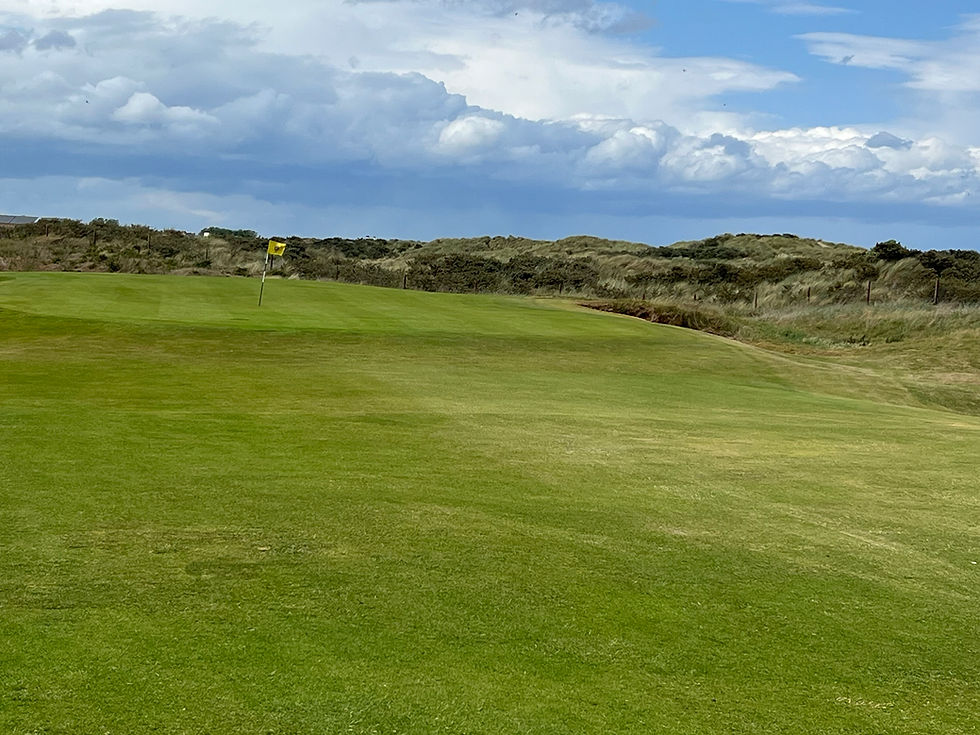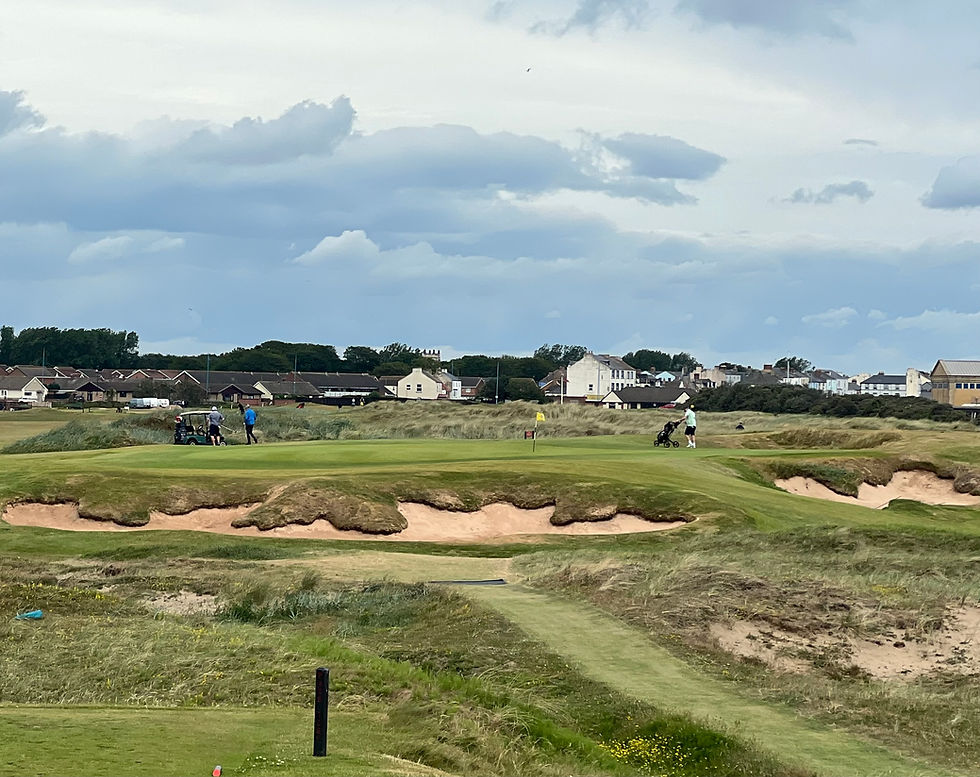Seaton Carew (revisited)
- Neil White
- Jul 11
- 4 min read

Four years ago, after playing a mixed open with Mrs. W, I wrote that Seaton Carew had "very high aspirations for the future."
"With its 150th anniversary on the horizon, it appointed Royal St. George's deputy greenkeeper, Tom Coulson, with the aim of recreating aspects of the Mackenzie-designed course to their original state."
The festivities are now over, and many changes have happened on the course—with more exciting ones being proposed.
My return for a society match play knockout rekindled happy memories of Mrs W and me being among the prizes on my last visit.
This time, a gale was blowing straight across us on 17 of the 18 holes.

Nevertheless, after we acclimatised to the wind, we managed to score decently in a game that was nip and tuck until the end.
Seaton Carew is a traditional members' club and prides itself on being the centre of its community. Its clubhouse was buzzing on the Sunday we visited.
After my two-and-a-half-hour journey, I squeezed in a tasty breakfast bap before a quick putt on the speedy practice green before embarking on our round.
We were told we could play off any tee of our choice, and my playing partner quipped: "We might take the reds", given the conditions.
Seaton Carew is the 10th oldest golf club in England, dating back to 1873. Its original 14 holes were extended to 18, and 33 years later, Dr. Alister Mackenzie redesigned the course nearer the dunes.

In the 1970s, four more holes were added by Frank Pennink, creating an unusual scenario that a day's round could be made up of five different possibilities of 18 from 22.
However, the complexities of that setup are now being reviewed, with the possibility that the club will revert to 18 holes, mixing new layouts with traditional ones.
In 2021, I highlighted Seaton Carew's industrial backdrop on one side but the missed opportunity of a better vista on the seaside.
That has been remedied by the removal of overgrown thickets of sea buckthorn.
Thankfully, they have gone, and some dramatic dunes fill the eyeline (I wish the sea were visible, but you cannot have everything).

There has also been considerable work on restoring bunkers to a more rustic appearance. For example, the especially testing pot bunkers around the third hole have been replaced.
My opponent and I had high expectations for our round after pleasing par fours on the opening hole, where out-of-bounds on the right with grassy hillocks prompt worry off the tee.
Bunkers lurk just short of the target, but fortunately, there was enough power on our approaches.
The improved par-three third is one of the most memorable holes, requiring precision club selection and hitting to find a table-top green. My ball took a fiendish slope into one of the new greenside traps.
We found the short holes very challenging because of the fierce wind. None more so than the sixth—a 168-yarder with bunkers to the right of the target.

Both shots were blown way right, and we halved in five!
Fortunately, a lightbulb moment occurred, and from that point onwards, my game came together.
The improvement began on the seventh, a par-four that was reachable in two if thick grassy dunes down the right could be avoided.
There was more unexpected happiness on the eighth, a tricky dogleg par-four that will have bigger hitters licking their lips over the prospect of cutting the corner. However, those who come up short will find heavy rough or even a prickly bush.
Our best efforts of the day were on the 370-yard 12th, the only hole with the wind directly at our backs.
My opponent scorched his drive 302 yards while mine was in the dunes to the right. I rescued the situation with an approach to about 15 feet from the two-tiered green.
I had a shot on the hole and needed it because my playing partner clipped his shot to a similar distance and nailed the birdie!

The 13th is a fun par-five with a sharp dogleg to the right over a protruding out-of-bounds.
Stronger players will be able to go for the green in two, but I found myself behind a dune after my second shot, recovering with a blind chip from the sandy rough.
It was followed by a 200-yard par-three that was straight into the fierce wind and had me reaching for my driver. An unlikely par was recorded.
Indeed, five consecutive scores in regulation meant that handshakes followed the bending par-four 16th—but only after the flag intervened on my behalf.
My opponent struck the most magnificent drive and sailed a chip that appeared bound to rest next to the hole, only for the ball to be grabbed by the fluttering flag and deposited off the green.

He made a superb attempt at birdie but skimmed the cup, and my more conventional par was enough for the win.
However, we were keen to play the last two holes and the 17th as challenges for best on the course.
This par-four bends to the right with plenty of rough ready to gobble drives that go too long.
Its stand-out element is a wildly undulating green that is surrounded by bunkers. It is a fiendishly complex putting surface.

The 18th brought back memories of our last visit and an implosion by Mrs W and me, who were leading the competition when we both slashed drives into bushes of sea buckthorn down the right.
But the abiding memory of that hole is how close the target is to the practice putting surface just beyond it, and the clubhouse to the rear. I can imagine many a good score being wrecked by the ball rolling onto one or the other.
Thankfully, ours found neither, and we darted away from the first spots of a shower, content that we had enjoyed a course on the up and one that deserves regular visits.





AYAMTOTO | TOTO SLOT | TOTO TOGEL
AYAMTOTO | TOTO SLOT | TOTO TOGEL
AYAMTOTO | TOTO SLOT | TOTO TOGEL
AYAMTOTO | TOTO SLOT | TOTO TOGEL
AYAMTOTO | TOTO SLOT | TOTO TOGEL
AYAMTOTO | TOTO SLOT | TOTO TOGEL
AYAMTOTO | TOTO SLOT | TOTO TOGEL
AYAMTOTO | TOTO SLOT | TOTO TOGEL
AYAMTOTO | TOTO SLOT | TOTO TOGEL
AYAMTOTO | TOTO SLOT | TOTO TOGEL
AYAMTOTO | TOTO SLOT | TOTO TOGEL
AYAMTOTO | TOTO SLOT | TOTO TOGEL
AYAMTOTO | TOTO SLOT | TOTO TOGEL
AYAMTOTO | TOTO SLOT | TOTO TOGEL
AYAMTOTO | TOTO SLOT | TOTO TOGEL
AYAMTOTO | TOTO SLOT | TOTO TOGEL
AYAMTOTO | TOTO SLOT | TOTO TOGEL
AYAMTOTO | TOTO SLOT | TOTO TOGEL
AYAMTOTO | TOTO SLOT | TOTO TOGEL
AYAMTOTO | TOTO SLOT | TOTO TOGEL
AYAMTOTO | TOTO SLOT | TOTO TOGEL
AYAMTOTO | TOTO SLOT | TOTO TOGEL
AYAMTOTO | TOTO SLOT | TOTO TOGEL
AYAMTOTO | TOTO SLOT | TOTO TOGEL